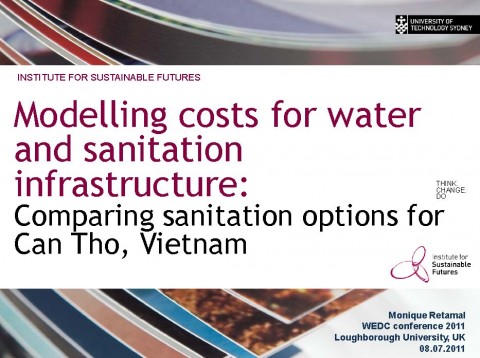Modelling costs for water and sanitation infrastructure: Comparing sanitation options for Can Tho, Vietnam
Retamal, M., Willets, J., Mitchell, C., Carrard, N. (2011)

Published in: 2011
Publisher:
35th WEDC International Conference, Loughborough, UK
Author:
Retamal, M., Willets, J., Mitchell, C., Carrard, N.
Uploaded by:
SuSanA secretariat
Partner profile:
common upload
4559 Views
113 Downloads
Location of library entry
Content - Summary
Assessing the cost-effectiveness of water and sanitation infrastructure options can be a valuable aid to decision making, particularly when comparing options with very different technologies, modes of operation,
scales (from decentralised to centralised), water sources and wastewater streams. With the growing complexity of infrastructure options, finding a comparable basis is increasingly important. Costeffectiveness analysis involves accounting for the capital, operating and asset replacement costs as well as the avoided costs and benefits over a period of time and comparing alternative options relative to a base case. In parallel, the demand for water or sanitation services is modelled over time so that the costs of infrastructure can be related to the service provided over its life cycle. Using this method, the costs borne by all parties can be considered, for example: costs to government, the customer, the utility and so on, in order to calculate a total cost to society. The objective is to identify and choose the option with the least cost to society. This is important because investment in infrastructure is often government funded, even in developing country contexts (Hall and Lobina 2010) and governments need to make effective investments across multiple types of infrastructure. This approach of including life cycle costs as well as multiple cost perspectives provides a more holistic view of the costs associated with infrastructure implementation.
Bibliographic information
Retamal, M., Willets, J., Mitchell, C., Carrard, N. (2011). Modelling costs for water and sanitation infrastructure: Comparing sanitation options for Can Tho, Vietnam. 35th WEDC International Conference, Loughborough, UK
Filter tags
East Asia & Pacific English















